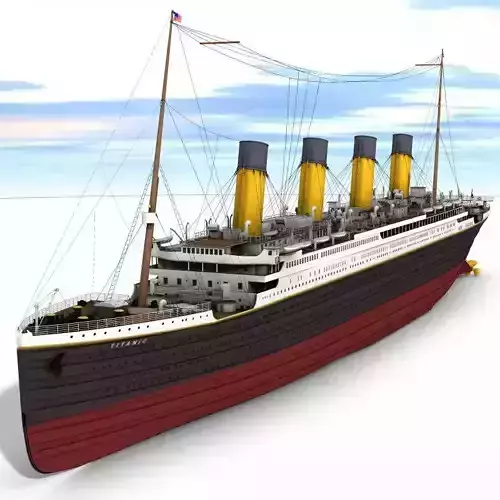1/7
The Titanic was a British Olympic class passenger liner that became infamous for her collision with an iceberg on 14 April 1912 and dramatic sinking on 15 April 1912. The second of a trio of superliners, Titanic and her sisters were designed to provide a three-ship weekly express service and dominate the transatlantic travel business for the White Star Line.
Titanic was 882 feet 9 inches (269 m) long and 92 feet 6 inches (28 m) at the beam (6 inches longer than twin ship RMS Olympic). She had a Gross Register Tonnage of 46,328 tons, and a height from the water line to the boat deck of 60 feet (18 m). She contained two reciprocating four-cylinder, triple-expansion, inverted steam engines and one low-pressure Parsons turbine. These powered three propellers. There were 25 double-ended and 4 single-ended Scotch-type boilers fired by 159 coal burning furnaces that made possible a top speed of 23 knots (43 km/h). Only three of the four 63 foot (19 m) tall funnels were functional; the fourth, which served only as a vent, was added to make the ship look more impressive. Titanic could carry a total of 3,547 passengers and crew and, because she carried mail, her name was given the prefix RMS (Royal Mail Steamer) as well as SS (Steam Ship).
The Titanic was launched 31 May 1911 and its maiden voyage began 10 April 1912.
On 1 September 1985, Robert Ballard of the Woods Hole Oceanographic Institution finally found the Titanic. When the wreck was discovered by Robert Ballard and his crew, they found that the ship did in fact break in two as it sank. It was theorized that as the Titanic sank, the stern rose out of the water. It supposedly rose so high that the unsupported weight caused the ship to break in half, the crack starting at the upper deck. This became the accepted theory.
In 2005, new evidence suggested that in addition to the expected side damage, the ship also had sustained damage to the bottom of the hull (keel). This new evidence seemed to support a less popular theory that the crack which broke the Titanic in two started at the keel plates. This proposition is supported by Jack Thayer`s sketches.
In 1997, James Cameron made his epic movie about the Titanic`s maiden voyage. At the time, it was the most expensive movie ever made... some said it cost more than the Titanic itself! The movie went on to become the #1 top-grossing movie of all time and was the first movie ever to gross more than $1 billion (US) at the box office. The movie also won 11 Academy Awards, including "Best Picture" and "Best Director".
Product Features:
The product contains four resolutions of the model, the high resolution version being rigged for animation.
The model is highly detailed and textured.
This model is a 3DMax model, saved in version 7 as a MAX file, and requires 3DMax. It does not include any other formats to allow it to be opened in any other software. The model is rigged where appropriate, and mapped and textured.
The model has not been tested for use as a 3d printed model.
REVIEWS & COMMENTS
accuracy, and usability.







